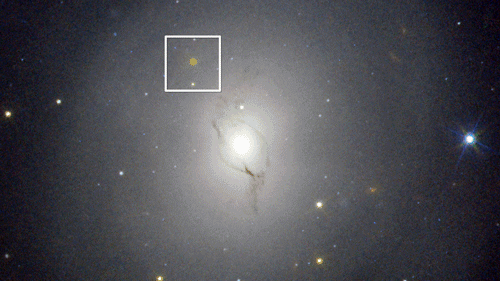Scientists have discovered a new way to probe the interiors of neutron stars by using gravitational waves to turn them into “cosmic tuning forks.” The reverberations of such ripples in spacetime could reveal the interiors of these extreme stellar remains.
Born when massive stars die, neutron stars have up to two times the mass of the sun crammed into a diameter of about 12 miles (20 kilometers). This means they are composed of the densest matter in the known universe. But because of their extreme characteristics, the interiors of these stellar remnants are shrouded in mystery.
Luciano Rezzolla and their research group at Goethe University Frankfurt theorize that the key to revealing the interiors of neutron stars could lie with collisions between these extreme stellar remnants. More precisely, the team thinks the key is to focus on how the daughter remnant of this violent collision sets spacetime ringing with gravitational waves.
“Just like tuning forks of different material will have different pure tones, remnants described by different equations of state will ring down at different frequencies,” Rezzolla said in a statement. “The detection of this signal thus has the potential to reveal what neutron stars are made of.”
Ringing spacetime
Gravitational waves were first suggested by Albert Einstein in this 1915 theory of gravity, known as general relativity.
General relativity suggests that gravity arises as a result of mass curving the very fabric of spacetime (the four-dimensional unification of space and time). In addition to this, when massive objects accelerate, they send out ripples in spacetime.
When two neutron stars exist in a binary system, as they circle around one another, they radiate gravitational waves.
This gravitational radiation carries angular momentum away from the binary system, causing the neutron stars to draw together. This increases the frequency of the emitted gravitational waves, meaning the system loses angular momentum quicker and quicker — and shrinks faster and faster.
That continues until the mutual gravity of the neutron stars takes over, and the stellar remnants collide, causing a cataclysmic explosion called a kilonova. This also sends out a scream of gravitational waves.
This process creates a massive, rapidly rotating post-merger remnant that also emits gravitational waves while spinning, albeit in a strong but narrow frequency range.
Rezzolla and colleagues propose these gravitational waves have encoded within them information about the interior of the post-merger remnant. More precisely, the “equation of state” of the nuclear matter within describes how matter behaves at extreme densities and pressures.
Using computer simulations of general relativity, the team found that the amplitude of the post-merger gravitational-wave signal diminishes over time. As this happens, the signal becomes increasingly “pure.” This means it begins to converge on a single frequency, akin to a giant tuning fork beginning to resonate after being struck.
The team has dubbed this phase of the signal’s evolution a “long ringdown.” The researcher theorize that there is a strong connection between the characteristics of the long ringdown and the properties of the densest regions in neutron-star cores.
Analysis of the long ringdown signal therefore reduces the uncertainties in the equation of state of matter at the incredibly high densities found within neutron stars.
“Thanks to advances in statistical modeling and high-precision simulations on Germany’s most powerful supercomputers, we have discovered a new phase of the long ringdown in neutron star mergers,” team leader Christian Ecker, a Goethe University researcher, said in the statement. “It has the potential to provide new and stringent constraints on the state of matter in neutron stars.”
Gravitational wave detectors like LIGO (Laser Interferometer Gravitational-Wave Observatory) and Virgo have been listening to these ripples in spacetime since 2015. However, a long ringdown signal such as the one discussed in this research is yet to be “heard.” The hope is that the next generation of gravitational wave detectors, including the space-based observatory LISA (Laser Interferometer Space Antenna) will be capable of making just such a detection.
“This finding paves the way for a better understanding of dense neutron star matter, especially as new events are observed in the future,” Ecker said.
The team’s research was published on Feb. 3 in the journal Nature Communications.
Source link
Read More
Read More
Visit Our Site
Read our previous article: Man City’s collapse against Real Madrid is a problem that has ruined their season but why is it happening? A side in decline | Football News
